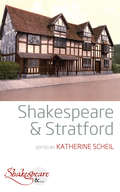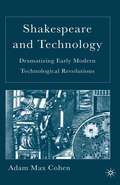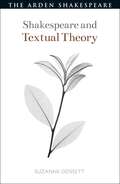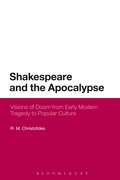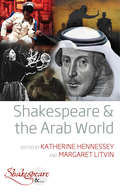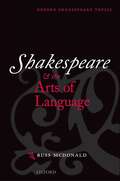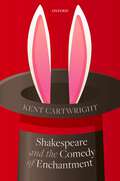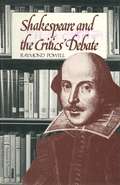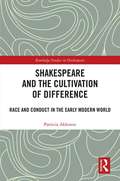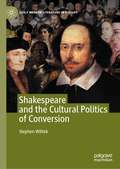- Table View
- List View
Shakespeare and Stratford (Shakespeare & #1)
by Katherine ScheilAs the site of literary pilgrimage since the eighteenth century, the home of the Royal Shakespeare Company and the topic of hundreds of imaginary portrayals, Stratford is ripe for analysis, both in terms of its factual existence and its fictional afterlife. The essays in this volume consider the various manifestations of the physical and metaphorical town on the Avon, across time, genre and place, from America to New Zealand, from children’s literature to wartime commemorations. We meet many Stratfords in this collection, real and imaginary, and the interplay between the two generates new visions of the place.
Shakespeare and Technology: Dramatizing Early Modern Technological Revolutions
by A. CohenBy reading the plays in technological contexts, Cohen offers new insights into some of Shakespeare's key metaphors, his methods of character development and plot development, his ideas about genre, his concept of theatrical space, and his views on the theatre's role in society.
Shakespeare and Terrorism (Spotlight on Shakespeare)
by Islam IssaShakespeare and Terrorism delves into how extremists have responded to Shakespeare – whether they’ve attacked him or been inspired by him – and investigates what the playwright and his works can tell us about the nature, psychology, and consequences of terror. Literary critic and historian Islam Issa takes readers on a journey from Shakespeare’s Stratford-upon-Avon and London to a variety of locations: from Western Europe to the Balkans to the US, from North Africa to the Persian Gulf to Central Asia, and from the theatre to the digital world. Considering incidents from Shakespeare’s time through today, including the Gunpowder Plot and 9/ 11, as well as pivotal figures from Hamlet and Macbeth to Hitler and Bin Laden, this book brings to light new ideas about key characters, events, and themes both in Shakespeare’s plays and the world around them. A thrilling and accessible read, this ground-breaking book will enlighten and engage students, researchers, and general readers interested in Shakespeare, social sciences, history, and the complex relationships between life and art.
Shakespeare and Terrorism (Spotlight on Shakespeare)
by Islam IssaShakespeare and Terrorism delves into how extremists have responded to Shakespeare – whether they’ve attacked him or been inspired by him – and investigates what the playwright and his works can tell us about the nature, psychology, and consequences of terror. Literary critic and historian Islam Issa takes readers on a journey from Shakespeare’s Stratford-upon-Avon and London to a variety of locations: from Western Europe to the Balkans to the US, from North Africa to the Persian Gulf to Central Asia, and from the theatre to the digital world. Considering incidents from Shakespeare’s time through today, including the Gunpowder Plot and 9/ 11, as well as pivotal figures from Hamlet and Macbeth to Hitler and Bin Laden, this book brings to light new ideas about key characters, events, and themes both in Shakespeare’s plays and the world around them. A thrilling and accessible read, this ground-breaking book will enlighten and engage students, researchers, and general readers interested in Shakespeare, social sciences, history, and the complex relationships between life and art.
Shakespeare and Text: Revised Edition (Oxford Shakespeare Topics)
by John JowettShakespeare and Text is built on the research and experience of a leading expert on Shakespeare editing and textual studies. The first edition has proved its value as an indispensable and unique guide to its topic. It takes Shakespeare readers to the very foundation of his work, explaining how his plays first took shape in the theatre where writing was part of a larger collective enterprise. The account examines the early modern printing industry that produced the earliest surviving texts of Shakespeare's plays. It describes the roles of publisher and printer, the controls exerted through the Stationers' Company, and the technology of printing. A chapter is devoted to the book that gathered Shakespeare's plays together for the first time, the First Folio of 1623. Shakespeare and Text goes on to survey the major developments in textual studies over the past century. It builds on the recent upsurge of interest in textual theory, and deals with issues such as collaboration, the instability of the text, the relationship between theatre culture and print culture, and the book as a material object. Later chapters examine the current critical edition, explaining the procedures that transform early texts in to a very different cultural artefact, the edition in which we regularly encounter Shakespeare. The new revised edition, which builds on Jowett's research for the New Oxford Shakespeare, engages with scholarship of the past decade, work that has transformed our understanding of textual versions, has opened up the taxonomy of Shakespeare's texts, and has significantly extended the picture of Shakespeare as a co-author. A new chapter describes digital text, digital editing, and their interface with the traditional media.
Shakespeare and Text: Revised Edition (Oxford Shakespeare Topics)
by John JowettShakespeare and Text is built on the research and experience of a leading expert on Shakespeare editing and textual studies. The first edition has proved its value as an indispensable and unique guide to its topic. It takes Shakespeare readers to the very foundation of his work, explaining how his plays first took shape in the theatre where writing was part of a larger collective enterprise. The account examines the early modern printing industry that produced the earliest surviving texts of Shakespeare's plays. It describes the roles of publisher and printer, the controls exerted through the Stationers' Company, and the technology of printing. A chapter is devoted to the book that gathered Shakespeare's plays together for the first time, the First Folio of 1623. Shakespeare and Text goes on to survey the major developments in textual studies over the past century. It builds on the recent upsurge of interest in textual theory, and deals with issues such as collaboration, the instability of the text, the relationship between theatre culture and print culture, and the book as a material object. Later chapters examine the current critical edition, explaining the procedures that transform early texts in to a very different cultural artefact, the edition in which we regularly encounter Shakespeare. The new revised edition, which builds on Jowett's research for the New Oxford Shakespeare, engages with scholarship of the past decade, work that has transformed our understanding of textual versions, has opened up the taxonomy of Shakespeare's texts, and has significantly extended the picture of Shakespeare as a co-author. A new chapter describes digital text, digital editing, and their interface with the traditional media.
Shakespeare and Textual Theory (Shakespeare and Theory)
by Suzanne GossettThere is no Shakespeare without text. Yet readers often do not realize that the words in the book they hold, like the dialogue they hear from the stage, has been revised, augmented and emended since Shakespeare's lifetime. An essential resource for the history of Shakespeare on the page, Shakespeare and Textual Theory traces the explanatory underpinnings of these changes through the centuries. After providing an introduction to early modern printing practices, Suzanne Gossett describes the original quartos and folios as well as the first collected editions. Subsequent sections summarize the work of the 'New Bibliographers' and the radical challenge to their technical analysis posed by poststructuralist theory, which undermined the presumed stability of author and text. Shakespeare and Textual Theory presents a balanced view of the current theoretical debates, which include the nature of the surviving texts we call Shakespeare's; the relationship of the author 'Shakespeare' and of authorial intentions to any of these texts; the extent and nature of Shakespeare's collaboration with others; and the best or most desirable way to present the texts - in editions or performances. The book is illustrated throughout with examples showing how theoretical decisions affect the text of Shakespeare's plays, and case studies of Hamlet and Pericles demonstrate how different theories complicate both text and meaning, whether a play survives in one version or several. The conclusion summarizes the many ways in which beliefs about Shakespeare's texts have changed over the centuries.
Shakespeare and Textual Theory (Shakespeare and Theory)
by Suzanne GossettThere is no Shakespeare without text. Yet readers often do not realize that the words in the book they hold, like the dialogue they hear from the stage, has been revised, augmented and emended since Shakespeare's lifetime. An essential resource for the history of Shakespeare on the page, Shakespeare and Textual Theory traces the explanatory underpinnings of these changes through the centuries. After providing an introduction to early modern printing practices, Suzanne Gossett describes the original quartos and folios as well as the first collected editions. Subsequent sections summarize the work of the 'New Bibliographers' and the radical challenge to their technical analysis posed by poststructuralist theory, which undermined the presumed stability of author and text. Shakespeare and Textual Theory presents a balanced view of the current theoretical debates, which include the nature of the surviving texts we call Shakespeare's; the relationship of the author 'Shakespeare' and of authorial intentions to any of these texts; the extent and nature of Shakespeare's collaboration with others; and the best or most desirable way to present the texts - in editions or performances. The book is illustrated throughout with examples showing how theoretical decisions affect the text of Shakespeare's plays, and case studies of Hamlet and Pericles demonstrate how different theories complicate both text and meaning, whether a play survives in one version or several. The conclusion summarizes the many ways in which beliefs about Shakespeare's texts have changed over the centuries.
Shakespeare and the 99%: Literary Studies, the Profession, and the Production of Inequity
by Sharon O’Dair Timothy FranciscoThrough the discursive political lenses of Occupy Wall Street and the 99%, this volume of essays examines the study of Shakespeare and of literature more generally in today’s climate of educational and professional uncertainty. Acknowledging the problematic relationship of higher education to the production of inequity and hierarchy in our society, essays in this book examine the profession, our pedagogy, and our scholarship in an effort to direct Shakespeare studies, literary studies, and higher education itself toward greater equity for students and professors. Covering a range of topics from diverse positions and perspectives, these essays confront and question foundational assumptions about higher education, and hence society, including intellectual merit and institutional status. These essays comprise a timely conversation critical for understanding our profession in “post-Occupy” America.
Shakespeare and the Actor (Oxford Shakespeare Topics)
by Lois PotterWhat is a 'Shakespearean actor'? Does the term still have any meaning? Drawing on the biographical and autobiographical accounts of actors and directors, as well as on interviews with actors from a wide range of backgrounds, this book looks at these questions in a variety of contexts, historical and contemporary. A survey of the training of the classical actor, with its increasing vocal and physical demands, considers how it, like its subsequent career path, is affected by class and gender. There is discussion of the uneasy balance of power between actors and directors, rehearsal practice, the difficulties faced by women as performers and directors, and attempts at undirected productions. Other chapters consider the roles that actors do and don't want to play, and why, their relation to the Shakespeare text and editorial practice, the complex relationship between actor and audience, and the popularity of anecdotes about things that go wrong. Throughout, examples are taken, as far as possible, from the author's own long experience of theatregoing. A final chapter looks at new trends in the theatre that have been accelerated by the long period of closure during the pandemic, particularly attempts at greater inclusivity in both actors and audiences. It concludes that the main reason Shakespeare is performed is that actors want to play the roles he wrote.
Shakespeare and the Actor (Oxford Shakespeare Topics)
by Lois PotterWhat is a 'Shakespearean actor'? Does the term still have any meaning? Drawing on the biographical and autobiographical accounts of actors and directors, as well as on interviews with actors from a wide range of backgrounds, this book looks at these questions in a variety of contexts, historical and contemporary. A survey of the training of the classical actor, with its increasing vocal and physical demands, considers how it, like its subsequent career path, is affected by class and gender. There is discussion of the uneasy balance of power between actors and directors, rehearsal practice, the difficulties faced by women as performers and directors, and attempts at undirected productions. Other chapters consider the roles that actors do and don't want to play, and why, their relation to the Shakespeare text and editorial practice, the complex relationship between actor and audience, and the popularity of anecdotes about things that go wrong. Throughout, examples are taken, as far as possible, from the author's own long experience of theatregoing. A final chapter looks at new trends in the theatre that have been accelerated by the long period of closure during the pandemic, particularly attempts at greater inclusivity in both actors and audiences. It concludes that the main reason Shakespeare is performed is that actors want to play the roles he wrote.
Shakespeare and the Afterlife (Oxford Shakespeare Topics)
by John S. GarrisonThe question of what happens after death was a vital one in Shakespeare's time, as it is today. And, like today, the answers were by no means universally agreed upon. Early moderns held surprisingly diverse beliefs about the afterlife and about how earthly life affected one's fate after death. Was death akin to a sleep where one did not wake until judgment day? Were sick bodies healed in heaven? Did sinners experience torment after death? Would an individual reunite with loved ones in the afterlife? Could the dead communicate with the world of the living? Could the living affect the state of souls after death? How should the dead be commemorated? Could the dead return to life? Was immortality possible? The wide array of possible answers to these questions across Shakespeare's work can be surprising. Exploring how particular texts and characters answer these questions, Shakespeare and the Afterlife showcases the vitality and originality of the author's language and thinking. We encounter characters with very personal visions of what awaits them after death, and these visions reveal new insights into these individuals' motivations and concerns as they navigate the world of the living. Shakespeare and the Afterlife encourages us to engage with the author's work with new insight and new curiosity. The volume connects some of the best-known speeches, characters, and conflicts to cultural debates and traditions circulating during Shakespeare's time.
Shakespeare and the Apocalypse: Visions of Doom from Early Modern Tragedy to Popular Culture (Continuum Shakespeare Studies)
by R M ChristofidesBy connecting Shakespeare's language to the stunning artwork that depicted the end of the world, this study provides not only provides a new reading of Shakespeare but illustrates how apocalyptic art continues to influence popular culture today.Drawing on extant examples of medieval imagery, Roger Christofides uses poststructuralist and psychoanalytic accounts of how language works to shed new light on our understanding of Hamlet, Othello, Macbeth, and King Lear. He then links Shakespeare's dependence on his audience to appreciate the allusions made to the religious paintings to the present day. For instance, popular television series like Battlestar Galactica, seminal horror movies such as An American Werewolf in London and Carrie and recent novels like Cormac McCarthy's The Road. All draw on imagery that can be traced directly back to the depictions of the Doom, an indication of the cultural power these vivid imaginings of the end of the world have in Shakespeare's day and now.
Shakespeare and the Apocalypse: Visions of Doom from Early Modern Tragedy to Popular Culture (Continuum Shakespeare Studies)
by R M ChristofidesBy connecting Shakespeare's language to the stunning artwork that depicted the end of the world, this study provides not only provides a new reading of Shakespeare but illustrates how apocalyptic art continues to influence popular culture today.Drawing on extant examples of medieval imagery, Roger Christofides uses poststructuralist and psychoanalytic accounts of how language works to shed new light on our understanding of Hamlet, Othello, Macbeth, and King Lear. He then links Shakespeare's dependence on his audience to appreciate the allusions made to the religious paintings to the present day. For instance, popular television series like Battlestar Galactica, seminal horror movies such as An American Werewolf in London and Carrie and recent novels like Cormac McCarthy's The Road. All draw on imagery that can be traced directly back to the depictions of the Doom, an indication of the cultural power these vivid imaginings of the end of the world have in Shakespeare's day and now.
Shakespeare and the Arab World (Shakespeare & #3)
by Katherine Hennessey and Margaret LitvinOffering a variety of perspectives on the history and role of Arab Shakespeare translation, production, adaptation and criticism, this volume explores both international and locally focused Arab/ic appropriations of Shakespeare’s plays and sonnets. In addition to Egyptian and Palestinian theatre, the contributors to this collection examine everything from an Omani performance in Qatar and an Upper Egyptian television series to the origin of the sonnets to an English-language novel about the Lebanese civil war. Addressing materials produced in several languages from literary Arabic (fuṣḥā) and Egyptian colloquial Arabic (‘ammiyya) to Swedish and French, these scholars and translators vary in discipline and origin, and together exhibit the diversity and vibrancy of this field.
Shakespeare and the Arts of Language (Oxford Shakespeare Topics)
by Russ McDonaldOxford Shakespeare Topics provide students and teachers with short books on important aspects of Shakespeare criticism and scholarship. Each book is written by an authority in its field, and combines accessible style with original discussion of its subject. Notes and a critical guide to further reading equip the interested reader with the means to broaden research. For the modern reader or playgoer, English as Shakespeare used it can seem alien and puzzling: vocabulary and grammar are in transition, pronouns and verb-forms can seem unfamiliar. Moreover, the conventions of poetic drama may also pose an impediment. Shakespeare and the Arts of Language provides a clear and helpful guide to the linguistic and rhetorical dimensions of the plays and poems. Written in a lucid, non-technical style, the book starts with the story of how the English language changed throughout the sixteenth century. Subsequent chapters define Shakespeare's main artistic tools and illustrate their poetic and theatrical contributions: Renaissance rhetoric, imagery and metaphor, blank verse, prose speech, and wordplay. The conclusion surveys Shakespeare's multiple and often conflicting ideas about language, encompassing both his enthusiasm at what words can do for us and his suspicion of what words can do to us. Throughout, Russ McDonald helps his readers to appreciate a play's concerns and theatrical effects by thinking about its language in relation to other writings of the period. He also emphasizes pleasure in the physical properties of Shakespeare's words: their colour, weight, and texture, the appeal of verbal patterns, and the irresistible power of intensified language.
Shakespeare and the Awareness of Audience (Routledge Revivals)
by Ralph BerryThis book, first published in 1985, explores the consciousness and the experience of Shakespeare’s audience. First describing the stage’s physical impact, Ralph Berry then goes on to explore the social or tribal consciousness of the audience in certain plays. The title finishes by examining the masque – the salient form of the Jacobean theatre. This title will be of interest to students of literature and theatre studies.
Shakespeare and the Awareness of Audience (Routledge Revivals)
by Ralph BerryThis book, first published in 1985, explores the consciousness and the experience of Shakespeare’s audience. First describing the stage’s physical impact, Ralph Berry then goes on to explore the social or tribal consciousness of the audience in certain plays. The title finishes by examining the masque – the salient form of the Jacobean theatre. This title will be of interest to students of literature and theatre studies.
Shakespeare and the Comedy of Enchantment
by Kent CartwrightShakespeare and the Comedy of Enchantment argues that enchantment constitutes a key emotional and intellectual dimension of Shakespeare's comedies. It thus makes a new claim about the rejuvenating value of comedy for individuals and society. Shakespeare's comedies orchestrate ongoing encounters between the rational and the mysterious, between doubt and fascination, with feelings moved by elements of enchantment that also seem a little ridiculous. In such a drama, lines of causality become complex, and even satisfying endings leave certain matters incomplete and contingent—openings for scrutiny and thought. In addressing enchantment, the book takes exception to the modernist vision of a deterministic 'disenchanted' world. As Shakespeare's action advances, comic mysteries accrue—uncanny coincidences; magical sympathies; inexplicable repetitions; psychic influences; and puzzlements about the meaning of events—all of whose numinous effects linger ambiguously after reason has apparently answered the play's questions. Separate chapters explore the devices, tropes, and motifs of enchantment: magical clowns who alter the action through stop-time interludes; structural repetitions that suggest mysteriously converging, even opaquely providential destinies; locales that oppose magical and protean forces to regulatory and quotidian values; desires, thoughts, and utterances that 'manifest' comically monstrous events; characters who return from the dead, facilitated by the desires of the living; play-endings crossed by harmony and dissonance, with moments of wonder that make possible the mysterious action of forgiveness. Wonder and wondering in Shakespeare's and other comedies, it emerges, become the conditions for new possibilities. Chapters refer extensively to early modern history, Renaissance and modern theories of comedy, treatises on magical science, and contemporaneous Italian and Tudor comedy.
Shakespeare and the Comedy of Enchantment
by Kent CartwrightShakespeare and the Comedy of Enchantment argues that enchantment constitutes a key emotional and intellectual dimension of Shakespeare's comedies. It thus makes a new claim about the rejuvenating value of comedy for individuals and society. Shakespeare's comedies orchestrate ongoing encounters between the rational and the mysterious, between doubt and fascination, with feelings moved by elements of enchantment that also seem a little ridiculous. In such a drama, lines of causality become complex, and even satisfying endings leave certain matters incomplete and contingent—openings for scrutiny and thought. In addressing enchantment, the book takes exception to the modernist vision of a deterministic 'disenchanted' world. As Shakespeare's action advances, comic mysteries accrue—uncanny coincidences; magical sympathies; inexplicable repetitions; psychic influences; and puzzlements about the meaning of events—all of whose numinous effects linger ambiguously after reason has apparently answered the play's questions. Separate chapters explore the devices, tropes, and motifs of enchantment: magical clowns who alter the action through stop-time interludes; structural repetitions that suggest mysteriously converging, even opaquely providential destinies; locales that oppose magical and protean forces to regulatory and quotidian values; desires, thoughts, and utterances that 'manifest' comically monstrous events; characters who return from the dead, facilitated by the desires of the living; play-endings crossed by harmony and dissonance, with moments of wonder that make possible the mysterious action of forgiveness. Wonder and wondering in Shakespeare's and other comedies, it emerges, become the conditions for new possibilities. Chapters refer extensively to early modern history, Renaissance and modern theories of comedy, treatises on magical science, and contemporaneous Italian and Tudor comedy.
Shakespeare and the Cultivation of Difference: Race and Conduct in the Early Modern World (Routledge Studies in Shakespeare)
by Patricia AkhimieShakespeare and the Cultivation of Difference reveals the relationship between racial discrimination and the struggle for upward social mobility in the early modern world. Reading Shakespeare’s plays alongside contemporaneous conduct literature - how-to books on self-improvement - this book demonstrates the ways that the pursuit of personal improvement was accomplished by the simultaneous stigmatization of particular kinds of difference. The widespread belief that one could better, or cultivate, oneself through proper conduct was coupled with an equally widespread belief that certain markers (including but not limited to "blackness"), indicated an inability to conduct oneself properly, laying the foundation for what we now call "racism." A careful reading of Shakespeare’s plays reveals a recurring critique of the conduct system voiced, for example, by malcontents and social climbers like Iago and Caliban, and embodied in the struggles of earnest strivers like Othello, Bottom, Dromio of Ephesus, and Dromio of Syracuse, whose bodies are bruised, pinched, blackened, and otherwise indelibly marked as uncultivatable. By approaching race through the discourse of conduct, this volume not only exposes the epistemic violence toward stigmatized others that lies at the heart of self-cultivation, but also contributes to the broader definition of race that has emerged in recent studies of cross-cultural encounter, colonialism, and the global early modern world.
Shakespeare and the Cultivation of Difference: Race and Conduct in the Early Modern World (Routledge Studies in Shakespeare)
by Patricia AkhimieShakespeare and the Cultivation of Difference reveals the relationship between racial discrimination and the struggle for upward social mobility in the early modern world. Reading Shakespeare’s plays alongside contemporaneous conduct literature - how-to books on self-improvement - this book demonstrates the ways that the pursuit of personal improvement was accomplished by the simultaneous stigmatization of particular kinds of difference. The widespread belief that one could better, or cultivate, oneself through proper conduct was coupled with an equally widespread belief that certain markers (including but not limited to "blackness"), indicated an inability to conduct oneself properly, laying the foundation for what we now call "racism." A careful reading of Shakespeare’s plays reveals a recurring critique of the conduct system voiced, for example, by malcontents and social climbers like Iago and Caliban, and embodied in the struggles of earnest strivers like Othello, Bottom, Dromio of Ephesus, and Dromio of Syracuse, whose bodies are bruised, pinched, blackened, and otherwise indelibly marked as uncultivatable. By approaching race through the discourse of conduct, this volume not only exposes the epistemic violence toward stigmatized others that lies at the heart of self-cultivation, but also contributes to the broader definition of race that has emerged in recent studies of cross-cultural encounter, colonialism, and the global early modern world.
Shakespeare and the Cultural Politics of Conversion (Early Modern Literature in History)
by Stephen WittekThis book takes a close look at Shakespeare’s engagement with the flurry of controversy and activity surrounding the concept of conversion in post-Reformation England. For playhouse audiences during the period, conversional thought encompassed a markedly diverse, fluid amalgamation of ideas, practices, and arguments centered on the means by which an individual could move from one category of identity to another. In an analysis that includes chapter-length readings of The Taming of the Shrew, Henry IV Part I, The Merchant of Venice, Othello, and The Tempest, the book argues that Shakespearean drama made a unique and substantive intervention in public discourse surrounding conversion, and continues to speak meaningfully about conversional experience for audiences in the present age. It will be of particular benefit to students and scholars with an interest in theatrical history, performance theory, theology, cultural studies, race studies, and gender studies.
Shakespeare and the Culture of Paradox
by Peter G. PlattExploring Shakespeare's intellectual interest in placing both characters and audiences in a state of uncertainty, mystery, and doubt, this book interrogates the use of paradox in Shakespeare's plays and in performance. By adopting this discourse-one in which opposites can co-exist and perspectives can be altered, and one that asks accepted opinions, beliefs, and truths to be reconsidered-Shakespeare used paradox to question love, gender, knowledge, and truth from multiple perspectives. Committed to situating literature within the larger culture, Peter Platt begins by examining the Renaissance culture of paradox in both the classical and Christian traditions. He then looks at selected plays in terms of paradox, including the geographical site of Venice in Othello and The Merchant of Venice, and equity law in The Comedy of Errors, Merchant, and Measure for Measure. Platt also considers the paradoxes of theater and live performance that were central to Shakespearean drama, such as the duality of the player, the boy-actor and gender, and the play/audience relationship in the Henriad, Hamlet, As You Like It, Twelfth Night, Antony and Cleopatra, The Winter's Tale, and The Tempest. In showing that Shakespeare's plays create and are created by a culture of paradox, Platt offers an exciting and innovative investigation of Shakespeare's cognitive and affective power over his audience.
